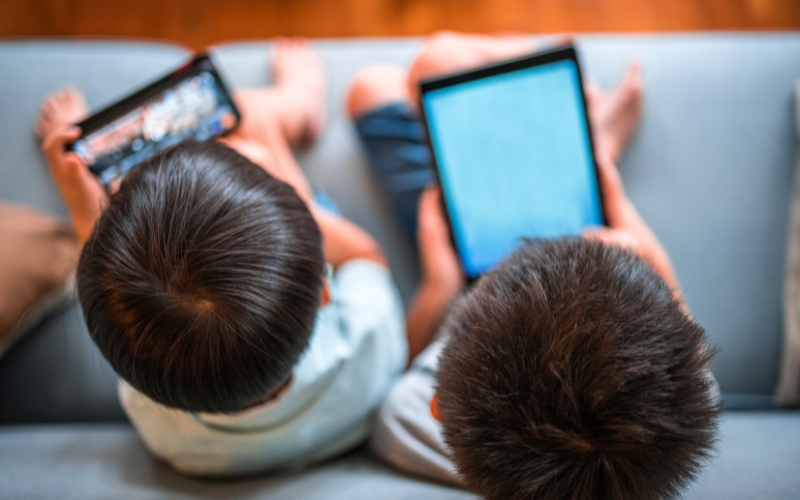See how screens strain children’s cognition, emotion, and connection—and how mindful media use can nurture balanced growth.
{{ vm.tagsGroup }}
03 Oct 2025
5 Min Read
Ishaanaah Ravi (Alumni Writer)
See how screens strain children’s cognition, emotion, and connection—and how mindful media use can nurture balanced growth.
In today’s screen-saturated world, it’s often easier for parents to hand their children a device to keep them entertained, and for teachers to turn to media as a convenient learning tool. These technologies can seem to offer instant solutions—holding attention, boosting engagement, and helping children stay connected in a society that’s always online. But while the benefits are real, constant exposure can come with hidden costs. For parents and teachers, it’s worth asking: Are we truly supporting our children’s development by relying so heavily on media? And for the ‘children’ themselves: Are you shaping your screen habits—or are they shaping you?
Technology has undoubtedly made life more accessible for children across the globe, but the growing saturation of screens is raising serious concerns about their development. Children are now exposed to fast-paced, visually stimulating content that constantly bombards their brains with information. While much of this content can be entertaining—and some of it educational—it also drives young minds into cognitive overload.
Cognitive overload occurs when the working memory is overwhelmed by too much information at once, disrupting the brain’s ability to process it efficiently or store it in long-term memory. Platforms like YouTube and TikTok increasingly feature sped-up content—faster videos and faster speech—making it harder to focus on longer-form content or linger on deep thought. Such content trains the mind to crave constant stimulation—so much so that even a goldfish, often cited to have a 9-second attention span (a metaphor, not a literal measure), seems to outlast us at 8 seconds.
These challenges also spill over into classrooms, whether online or offline, where media is used to deliver lessons. For example, a YouTube video explaining photosynthesis might aim to captivate, but if it’s too quick or cluttered, students may miss crucial information. Richard Mayer’s Cognitive Theory of Multimedia Learning proposes that when instructional content is poorly designed—overloading working memory with rapid transitions, excessive visuals, or dense information—it can derail meaningful learning, impairing both retention and knowledge transfer.
This constant bombardment of screens also takes a toll on emotional regulation. Research shows that children who were given devices to calm down were less able to think clearly and more prone to emotional reactions than those who were not. While screens may provide a short-term calming effect, they can have the opposite long-term effect—heightening emotional reactivity and making everyday frustrations more likely to trigger meltdowns or tantrums. Relying on devices also limits opportunities for children to develop independent strategies for self-regulation, practise social skills, or engage in active play, rippling into challenges with learning, attention, and physical health.
The growing prevalence of shortened attention spans among children poses serious consequences for the next generation. Research on undergraduate students found that frequent exposure to short-form videos (i.e., reels) is linked to a measurable decline in sustained attention during academic tasks. That decline can undermine academic success, underscoring how vital sustained attention is for student engagement, learning retention, and overall performance.
Excessive screen use may also contribute to emotional and behavioural challenges beyond academics. Studies link screen time of more than two hours daily with emotional problems like mood swings or irritability, and with conduct problems like acting out or difficulty following rules—disruptions that affect daily routines. It can also hinder social-emotional development, making it harder for children to recognise and manage emotions, increasing aggressive tendencies, and diminishing skills such as managing conflict, handling criticism, and coping with setbacks.
The effects extend to creativity. Children who spend long periods on digital devices—especially fast-paced, short-form content—miss activities that foster imaginative play, problem-solving, and open-ended thinking. Boredom, a key driver of creative thought, becomes rare. At the same time, the instant gratification of likes, comments, and notifications hijacks the brain’s dopamine system: anticipating and receiving these 'rewards' releases dopamine, reinforcing screen use and making it harder to switch off.
Amid the digital overload that shapes much of childhood today, it’s important for parents and teachers to promote slower-paced, thoughtfully designed content that nurtures attention, emotional regulation, and engagement. Think of traditional programmes like Sesame Street or the live-action Barney. They may seem simple by today’s standards, but their steady pacing and low sensory input provide a much-needed counterbalance to the relentless stream of high-intensity visuals and rapid-fire stimuli. By reintroducing content like this, children can still enjoy engaging stories and lessons—only now at a pace their brains can process without becoming overwhelmed.

More recently, programmes like Bluey take a similar approach but in a modern style. Its short, seven-minute episodes stand in stark contrast to the marathon viewing sessions many children experience on platforms like YouTube. The compact format delivers a complete story without overstimulation, while the calm pacing and gentle storytelling create a predictable, safe space for learning. Much like real-life play, it opens up opportunities for curiosity and discovery within clear boundaries.
Co-viewing can also make a significant difference in how children engage with media. When parents or teachers view content alongside children, they can guide the experience, prompt reflection, and spark conversation. This involvement helps children connect what they see on screen to real-life situations. It also allows them to practise social and emotional skills—such as articulating thoughts, expressing feelings, and taking another person’s perspective—in a context that strengthens understanding and deepens learning.
Beyond screens, it’s equally important to create time and space for offline experiences that develop real-world skills. Setting screen limits is a crucial first step—not to eliminate digital exposure entirely, but to make room for more mindful, balanced engagement. In the classroom, teachers can introduce hands-on experiments, collaborative projects, and inquiry-based learning, while at home, parents can encourage creative play, outdoor exploration, and face-to-face social interaction. Together, these experiences allow children to practise problem-solving, critical thinking, and decision-making, while also cultivating self-awareness, empathy, and emotional resilience. By striking a balance between online and offline worlds, we equip children with the tools they need to thrive academically, emotionally, and socially.
In an age where screens saturate nearly every moment of childhood (and beyond), the challenge isn’t about turning devices off, but about creating routines that support healthy development. While technology can offer incredible opportunities for learning and connection, not all media is created equal. Slower-paced content, guided co-viewing, and meaningful offline experiences help strengthen attention, build emotional resilience, and keep creativity alive. To parents and teachers, the goal is to make choices that support our children as they grow up in a digital world; and to ‘children’, it’s about reclaiming your focus, curiosity, and imagination—one ‘second’ at a time.
Ishaanaah Ravi is a Bachelor of Education (Honours) alumna from Taylor’s University and is currently pursuing a Master of Educational Studies at the University of Queensland. She enjoys breaking down educational topics into bite-sized insights and finds joy in simple pleasures, like volunteering, watching comedy shows, and building Lego sets.
